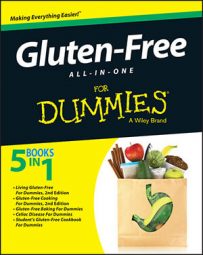Although some recipes are easier to adjust than others, almost any recipe can be made gluten-free. The easiest to change are recipes with only small amounts of flour and fare with high fruit and vegetable content. But even if your gluten-heavy Italian recipe calls for wheat pasta, just use a gluten-free pasta instead. And if you’re clean out of gluten-free pasta, knowing you can substitute rice, potatoes, risotto, spaghetti squash, or polenta in the recipe can save the day!
Omit ingredients. The first step in making a gluten-containing recipe gluten-free is to know which ingredients to avoid. While you search the ingredient list for items you can leave out, be sure to check the labels on ingredients you plan to use as well.
Replace the flour. Converting recipes that don’t contain a large amount of flour is easiest. If the recipe calls for only a little flour, then just swap out the gluten-containing flour for cornstarch, arrowroot powder, or any gluten-free flour or flour blend.
But if you’re preparing a recipe with more than just a few tablespoons of flour, you can’t throw in the same volume of gluten-free flour and have a recipe turn out well unless you use a blend. You can buy an all-purpose flour blend or make your own. Try 3 parts rice flour, 2 parts potato starch, 1 part tapioca flour, and 1 teaspoon of xanthan gum for every 1 1/2 cups of the flour mixture.
Keep it together with xantham gum. Xanthan gum is a natural soluble fiber that’s produced by fermenting a microorganism with sugar. It helps give dough a sticky consistency, and dough minus gluten really needs some help to stay together! If you’re just mixing a little gluten-free flour into gravy or a soup or using it for a coating, then no gum is required.
Add moisture to baked goods. Gluten-free flours tend to produce foods that are denser and drier than their gluten-containing cousins. Adding 1/4 cup applesauce, pumpkin puree, mayonnaise, or sour cream can improve the consistency.
Use alternative breading options. If a recipe calls for a fried or baked crispy coating on meat or veggies, use ingredients like gluten-free breadcrumbs, gluten-free flours, ground nuts, cornmeal, crushed potato chips or corn chips, instant mashed potato flakes, or crushed gluten-free cereal or crackers.
Reference gluten-free recipes. You don’t need to give up on favorite family recipes when you give up gluten! You just need to invent gluten-free versions. One way to figure out how to alter your recipe is to hunt for similar gluten-free recipes that have already been tried and published by someone else. If you want to make your grandma’s Spritz cookies, for example, there are certainly gluten-free cooks who have figured out similar cookie recipes. If you can’t find a gluten-free recipe for a specific dish, read through several recipes, looking for patterns that can help you alter your recipe. For example
Do the similar recipes you find tend to use certain flours? Which ones?
Do the recipes call for more or less liquid than the gluten-filled versions?
Do they tend to have more eggs or extra vanilla?
Do they tend to use the same cooking temperature and time?

